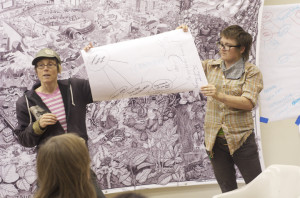
Courtesy Photo
By Liz Hitchcock
Reporter
The Croft Gallery hosted a unique show Saturday, March 24, by a group called The Beehive Collective that included three large fabric pieces and a gallery talk.
The Beehive Collective is a collaboration of artists, educators and organizers who create large-scale prints of densely illustrated images in order to teach people about environmental, economic and social problems that the world faces today.
Zeph Fishlyn, artist for The Beehive Collective, and Eryn Wheatley, an organizer for the group, visited a class focused on the Holocaust in Baylor’s Center for Jewish Studies last Thursday morning.
Following that lecture, they also visited the World Hunger Relief farm that afternoon to lecture about the environment and to tie their work into the farm’s work with sustainability.
“This is an idea that we can be involved and implicated in a system that’s impacting people that may be invisible to us,” Fishlyn said in her lecture.
“It’s easy from the vantage point of today to look back on the Holocaust and really ask how people in Germany didn’t see what was going on, and how did they let it happen. There are things in this present world that are happening that are invisible to us.”
Baylor alumnus Aaron Ellis previously listened to other “bees” from the organization speak at Common Grounds and contacted them to encourage a couple members to come back to Waco, and he organized Fishlyn and Wheatley’s visit to campus and the opportunity to guest lecture.
“Traditionally, art is viewed as art for art’s sake or as a mode of self-expression.” Ellis said. “The Beehive Collective thinks outside of that box. … The work is not done purely to make it, but it’s done to raise awareness about serious issues that impact people in the world. These issues don’t just affect people that are in the area that the banners focus on, but other people that can learn from their work as well.”
The group was originally formed in Machias, Maine, around 10 years ago, and it has about nine volunteers in its core group and another five or six people that work occasionally with the group. Members of The Beehive Collective live throughout the country and focus on bringing awareness of these issues to areas around them.
“This project started as a two-month research trip to Appalachia. … We started thinking about how to depict our part in the picture,” Fishlyn said. “We are all part of this system depicted in these pieces. There is a big chunk of initial research that was first-hand, talking to people in the area. Then more research as we went along, such as image research.”
The collective splits into up to three groups every year and tours the country with prints of their work on fabric.
The original copies of the work are mostly done in pen and ink, sometimes incorporating graphite and ink washes as well.
“It’s interesting to put these up in places where most people aren’t expecting it,” Fishlyn said. “Even if people find the pieces overwhelming, they will still come in and start picking out details it just takes a little bit of time. In formal settings, people think that they should come in and get it right away, but that isn’t really realistic.”
Members of the group travel through different states to hold workshops, lectures and shows at galleries speaking to groups ranging in age from elementary students to elderly people.
The group is anti-copyright and encourages anyone to use its images for educational tools as long as it is given recognition.
“There is a broad network of people that go on tour sometimes,” Wheatley said, “and an even broader network of people that use our posters for educational purposes.”
Each piece is representational of some sort of social issue, highlighting a community that may contain unjust activities, or a problem the world is facing with the environment. Using an illustrative and cartoon-like style, the collective creates intricate and dense drawings to portray these world issues and challenges.
“It’s also a collective process, where they not only research the issues on the banners,” Ellis said. “They talk to people that live in these areas. It’s not anomalous. It’s dense and hard to get at in the beginning, but with some help and guidance there is a clear narrative and messages being conveyed by the highly metaphorical representations used in their work.”
Fishlyn and Wheatley brought three different pieces with them to Waco for educational and display purposes. These pieces each incorporate a different issue, such as the timeline of the coal industry and its detrimental effects on the environment and the communities around large coal plants.
They also explore additional issues, as the effects of the war on drugs foreign policies in Columbia and issues involving free trade.
Within each piece, people are represented by animals; each species is specifically chosen to symbolize a specific message that their piece will convey.
The pieces also include a section that is solely based on the organizations take on a good solution to each problem.
“There is a lot in these pieces about resistance and alternatives, which is something that we put in all of our graphic campaigns,” Wheatley said. “It’s not just focusing on all the bad news, … but the resistance and the alternatives, not as abstract things in the future, but as things that are happening now.”
For more information, visit www.beehivecollective.org.



